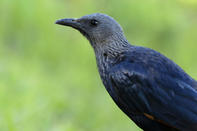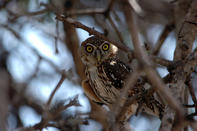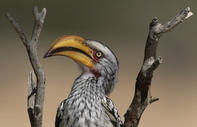Red Winged Starling

Although the red winged starling, Onychognathus morio, is found mainly in mountainous areas, where its mellow, whistling call is everywhere, it happily roosts and breeds in cities -- probably because the canyons created by high rise buildings resemble its favoured mountain kloofs. Red Winged starlings eat a variety of foods such as fruit, insects, ticks, lizards and nectar.
Small but Deadly

The smallest owl in southern Africa is the pearl spotted owl, Glaucidium perlatum. It weighs about 7 g at birth and only 60 g as an adult — the weight of a small tomato. However, it is a carnivore that can kill prey its own size, such as rodents, lizards, bats and insects. It is one of the region's few semi-diurnal owls and flies with fast, audible wingbeats (nocturnal owls fly silently).
Hornbills

Hornbills' nesting behaviour is complex and fascinating: the female seals herself, with mud, into a hollow tree trunk to lay her eggs, leaving a slit through which her mate passes food. In most species the female breaks herself out when the nestlings are about three weeks old, The young instinctively duplicate the seal and are fed by both parents until they are strong enough to fly, when they use their already huge beaks to leave the nest.
Yellow-billed hornbills, Tockus flavirostris, are typical of the family from their loud, staccato trumpetting to the rolling gait with which they dash about snatching up food. These omnivores also forage in trees for fruit and insects. One of the few members of the family which does not seal up its nest is the ungainly ground hornbill, Bucorvus leadbeateri, that struts the Bushveld floor in search of any small animal, including hares and tortoises.
Helmeted Guinea Fowl
Because of its versatility and hardiness, the helmeted guinea-fowl, Numida meleagris, is one of southern Africa's most common birds, a familiar sight everywhere but in the dry west. There are four races of the species in the region, differentiated by the size and shape of the 'helmet' or casque. A popular game bird, the guinea-fowl is tame enough when not persecuted.
The story of white storks Ciconia ciconia, begins gloomily enough. The numbers breeding in Europe and Asia, where their wetland habitats gave way for agriculture, have dropped alarmingly, and migrating birds are being shot by trigger-happy Middle East military men.
However, the results of the southern African stork census of October 1984-May 1985, and In particular the head count undertaken by members of the public during the weekend of 19-20 January 1985, were most encouraging.
A total of 25 491 white storks was seen in South Africa, Swaziland. Lesotho and Transkei an estimated one-tenth of the Eurasian population. Most of those were foraging in man-altered habitats, and nearly one-third in lucerne fields, where the big attraction was the caterpillars and crickets which farmers of this crop usually find uneconomical to treat with Insecticides.
Perhaps because of the decline of their northern habitat, a few small colonies such as this one have unexpectedly appeared In South Africa.
Ground Woodpecker
One of the ten woodpeckers found in Southern Africa is the ground woodpecker, Geocolaptes olivaceus, which is restricted to mountain and rocky habitats throughout most of the area, but avoids the driest west and a narrow belt along the east coast.
It usually perches, in small groups, on rocks, slipping over the edge at the approach of intruders. The distinctive plosive, followed by grating sound, of its alarm calls and the rolling screams of its contact calls make for easier identification.
The predominantly chrome-yellow colouring, black collar and distinctive calls of the, make it one of South Africa's more familiar smaller birds.